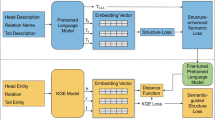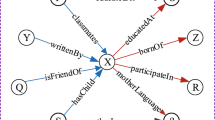Abstract
Representation learning of knowledge graphs has emerged as a powerful technique for various downstream tasks. In recent years, numerous research efforts have been made for knowledge graphs embedding. However, previous approaches usually have difficulty dealing with complex multi-relational knowledge graphs due to their shallow network architecture. In this paper, we propose a novel framework named Transformers with Contrastive learning for Knowledge Graph Embedding (TCKGE), which aims to learn complex semantics in multi-relational knowledge graphs with deep architectures. To effectively capture the rich semantics of knowledge graphs, our framework leverages the powerful Transformers to build a deep hierarchical architecture to dynamically learn the embeddings of entities and relations. To obtain more robust knowledge embeddings with our deep architecture, we design a contrastive learning scheme to facilitate optimization by exploring the effectiveness of several different data augmentation strategies. The experimental results on two benchmark datasets show the superior of TCKGE over state-of-the-art models.



Similar content being viewed by others
References
Lehmann J et al (2015) Dbpedia - a large-scale, multilingual knowledge base extracted from Wikipedia. Sem Web 6(2):167–195. https://doi.org/10.3233/SW-140134
Bollacker KD, Evans C, Paritosh PK, Sturge T, Taylor J (2008) Freebase: a collaboratively created graph database for structuring human knowledge, pp 1247–1250 (ACM)
Suchanek FM, Kasneci G, Weikum G (2007) Yago: a core of semantic knowledge, pp 697–706 (ACM)
IV, RL L, Liu NF, Peters ME, Gardner M, Singh S (2019) Barack’s wife hillary: using knowledge graphs for fact-aware language modeling, pp 5962–5971 (association for computational linguistics)
Zhang Z et al (2019) ERNIE: enhanced language representation with informative entities, pp 1441–1451 (association for computational linguistics)
Hayashi H, Hu Z, Xiong C, Neubig G (2020) Latent relation language models, AAAI Press, pp 7911–7918
Chaudhary C, Goyal P, Prasad DN, Chen YP (2020) Enhancing the quality of image tagging using a visio-textual knowledge base. IEEE Trans Multim 22(4):897–911. https://doi.org/10.1109/TMM.2019.2937181
Xue F et al (2020) Knowledge-based topic model for multi-modal social event analysis. IEEE Trans Multim 22(8):2098–2110. https://doi.org/10.1109/TMM.2019.2951194
Zhang X et al (2015) Enhancing video event recognition using automatically constructed semantic-visual knowledge base. IEEE Trans Multim 17(9):1562–1575. https://doi.org/10.1109/TMM.2015.2449660
Riedel S, Yao L, McCallum A, Marlin BM (2013) Relation extraction with matrix factorization and universal schemas, pp 74–84 (the association for computational linguistics)
Xiong W, Hoang T, Wang WY (2017) Deeppath: a reinforcement learning method for knowledge graph reasoning, pp 564–573 (association for computational linguistics)
Verga P, Sun H, Soares LB, Cohen WW (2020) Facts as experts: adaptable and interpretable neural memory over symbolic knowledge. CoRR . arXiv:2007.00849
Nickel M, Murphy K, Tresp V, Gabrilovich E (2016) A review of relational machine learning for knowledge graphs. Proc IEEE 104(1):11–33. https://doi.org/10.1109/JPROC.2015.2483592
Wang Q, Mao Z, Wang B, Guo L (2017) Knowledge graph embedding: a survey of approaches and applications. IEEE Trans Knowl Data Eng 29(12):2724–2743. https://doi.org/10.1109/TKDE.2017.2754499
Weston J, Bordes A, Yakhnenko O, Usunier N (2013) Connecting language and knowledge bases with embedding models for relation extraction, pp 1366–1371 (ACL). https://aclanthology.org/D13-1136/
Bordes A, Chopra S, Weston J (2014) Question answering with subgraph embeddings, pp 615–620 (ACL)
Reinanda R, Meij E, de Rijke M (2020) Knowledge graphs: an information retrieval perspective. Found Trends Inf Retr 14(4):289–444. https://doi.org/10.1561/1500000063
Guo Q et al (2022) A survey on knowledge graph-based recommender systems. IEEE Trans Knowl Data Eng 34(8):3549–3568. https://doi.org/10.1109/TKDE.2020.3028705
Ji S, Pan S, Cambria E, Marttinen P, Yu PS (2022) A survey on knowledge graphs: representation, acquisition, and applications. IEEE Trans Neural Netw Learn Syst 33(2):494–514. https://doi.org/10.1109/TNNLS.2021.3070843
Bordes A, Usunier N, García-Durán A, Weston J, Yakhnenko O (2013) Translating embeddings for modeling multi-relational data, pp 2787–2795
Yang B, Yih W, He X, Gao J, Deng L (2015) Embedding entities and relations for learning and inference in knowledge bases
Sun Z, Deng Z, Nie J, Tang J (2019) Rotate: knowledge graph embedding by relational rotation in complex space (OpenReview.net)
Schlichtkrull MS (2018) et al. Modeling relational data with graph convolutional networks, vol 10843. Springer, pp 593–607
Vashishth S, Sanyal S, Nitin V, Talukdar PP (2020) Composition-based multi-relational graph convolutional networks (OpenReview.net)
Dettmers T, Minervini P, Stenetorp P, Riedel S (2018) Convolutional 2d knowledge graph embeddings. AAAI Press, pp 1811–1818
Chen T, Kornblith S, Norouzi M, Hinton GE (2020) A simple framework for contrastive learning of visual representations, vol 119, pp 1597–1607 (PMLR)
Yan Y et al (2021) Consert: a contrastive framework for self-supervised sentence representation transfer, pp 5065–5075 (association for computational linguistics)
You Y et al (2020) Graph contrastive learning with augmentations
Wang Q et al (2019) Coke: contextualized knowledge graph embedding. CoRR . arXiv:1911.02168
Chen S et al (2021) Hitter: Hierarchical transformers for knowledge graph embeddings, pp 10395–10407 (association for computational linguistics)
Wang Z, Zhang J, Feng J, Chen Z (2014) Knowledge graph embedding by translating on hyperplanes. AAAI Press, pp 1112–1119
Lin Y, Liu Z, Sun M, Liu Y, Zhu X (2015) Learning entity and relation embeddings for knowledge graph completion. AAAI Press, pp 2181–2187
Ji G, He S, Xu L, Liu K, Zhao J (2015) Knowledge graph embedding via dynamic mapping matrix, pp 687–696 (the association for computer linguistics)
Jia Y, Wang Y, Lin H, Jin X, Cheng X (2016) Locally adaptive translation for knowledge graph embedding. AAAI Press, pp 992–998
Xiao H, Huang M, Hao Y, Zhu X (2015) Transg : a generative mixture model for knowledge graph embedding. CoRR. arXiv:1509.05488
Trouillon T, Welbl J, Riedel S, Gaussier É, Bouchard G (2016) Complex embeddings for simple link prediction, vol 48, pp 2071–2080 (JMLR.org)
Liu H, Wu Y, Yang Y (2017) Analogical inference for multi-relational embeddings, vol 70, pp 2168–2178 (PMLR)
Kazemi SM, Poole D (2018) Simple embedding for link prediction in knowledge graphs, pp 4289–4300
Balazevic I, Allen C, Hospedales TM (2019) Tucker: tensor factorization for knowledge graph completion, pp 5184–5193 (association for computational linguistics)
Chami I et al (2020) Low-dimensional hyperbolic knowledge graph embeddings, pp 6901–6914 (association for computational linguistics)
Nickel M, Tresp V, Kriegel H (2011) A three-way model for collective learning on multi-relational data, pp 809–816 (Omnipress)
Kipf TN, Welling M (2017) Semi-supervised classification with graph convolutional networks (OpenReview.net)
Zhu Y et al (2021) Graph contrastive learning with adaptive augmentation, pp 2069–2080 (ACM/IW3C2)
Hassani K, Ahmadi A HK (2020) Contrastive multi-view representation learning on graphs, vol 119, pp 4116–4126 (PMLR)
Zhang R, Lu C, Jiao Z, Li X (2021) Deep contrastive graph representation via adaptive homotopy learning. CoRR. arXiv:2106.09244
Velickovic P et al (2018) Deep graph infomax. CoRR. arXiv:1809.10341
Sun F, Hoffmann J, Verma V, Tang J (2020) Infograph: unsupervised and semi-supervised graph-level representation learning via mutual information maximization (OpenReview.net)
Wan S, Pan S, Yang J, Gong C (2021) Contrastive and generative graph convolutional networks for graph-based semi-supervised learning, AAAI Press, pp 10049–10057
Devlin J, Chang M, Lee K, Toutanova K (2019) BERT: pre-training of deep bidirectional transformers for language understanding, pp 4171–4186 (association for computational linguistics)
van den Oord A, Li Y, Vinyals O (2018) Representation learning with contrastive predictive coding. CoRR. arXiv:1807.03748
Toutanova K, Chen D (2015) Observed versus latent features for knowledge base and text inference. Association for Computational Linguistics, Beijing, China, pp 57–66
Miller GA (1995) Wordnet: a lexical database for English. Commun ACM 38(11):39–41. https://doi.org/10.1145/219717.219748
Broscheit S, Ruffinelli D, Kochsiek A, Betz P, Gemulla R (2020) Libkge - a knowledge graph embedding library for reproducible research, pp 165–174 (association for computational linguistics)
Vaswani A et al (2017) Attention is all you need, pp 5998–6008
Kingma DP, Ba J (2015) A method for stochastic optimization, Adam
Acknowledgements
This work was supported in part by the National Natural Science Foundation of China under Grants 62036012, 62072456, 62106262. This work is supported by Open Research Projects of Zhejiang Lab (NO. 2021KE0AB05)
Author information
Authors and Affiliations
Corresponding author
Ethics declarations
Conflict of interest
The authors declare that they have no conflict of interest.
Additional information
Publisher's Note
Springer Nature remains neutral with regard to jurisdictional claims in published maps and institutional affiliations.
Rights and permissions
Springer Nature or its licensor (e.g. a society or other partner) holds exclusive rights to this article under a publishing agreement with the author(s) or other rightsholder(s); author self-archiving of the accepted manuscript version of this article is solely governed by the terms of such publishing agreement and applicable law.
About this article
Cite this article
Zhang, X., Fang, Q., Hu, J. et al. TCKGE: Transformers with contrastive learning for knowledge graph embedding. Int J Multimed Info Retr 11, 589–597 (2022). https://doi.org/10.1007/s13735-022-00256-3
Received:
Revised:
Accepted:
Published:
Issue Date:
DOI: https://doi.org/10.1007/s13735-022-00256-3




